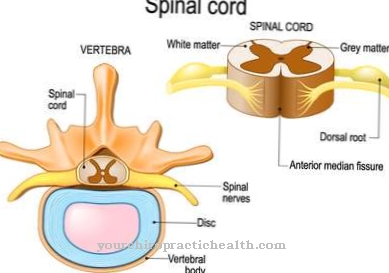Under one Lordosis a curvature of the spine in the anterior direction is understood. Hyperlordosis is a common malposition.
What is lordosis?

© Sagittaria - stock.adobe.com
In the Lordosis it is a curve of the spine that runs in the anterior direction. It forms the counterpart to kyphosis, in which the spine curve goes backwards. In the overall shape of the spine, the lordosis shows up in the neck region, while kyphosis occurs in the chest region. In addition, lordosis also occurs in the lumbar vertebra.
A distinction must be made between a lumbar lordosis and a cervical lordosis. If the lordosis leads to a poor posture, medicine speaks of a hyperlordosis or a hollow back. It shows up either in the cervical spine or in the lumbar spine.
Hyperlordosis is a poor posture in which there is an excessive curvature of the spine in the anterior direction. The exaggerated curvature becomes noticeable through damage to the spine and back pain. While the spine curves excessively forwards, the abdomen is simultaneously arched towards the front, while the chest is shifted behind the axis of the body.
In this way, the person concerned assumes a stable posture and does not tip over. In addition, the abdominal muscles prevent you from falling backwards. It is not uncommon for the people affected to appear as if they were carrying a heavy stomach, as in pregnancy.
causes
The causes for the development of a pathological lordosis are different. In some cases, hyperlordosis is already congenital, but this is rare. In most patients, the hollow back is formed by poor posture that lasts for a long time. Sometimes these bad postures are also the result of certain diseases, which include vertebral slippage (spondylolisthesis) or Pomarino's disease.
For most people, however, the lordosis is caused by a muscular imbalance. This comes about through incorrect postures such as permanent sitting or standing or lack of exercise. Unergonomic sitting in particular is often responsible for the development of hyperlordosis. This can be attributed to the rapid relaxation of the abdominal muscles.
However, along with the back and glutes, the abdominal muscles are important for stabilizing the spine. In addition, those affected often suffer from a lack of exercise, which in turn has a negative effect on muscle strength. For this reason, efficient compensation of the lordosis is no longer possible, which can lead to persistent misalignment.
Sometimes a shortening of the hip flexor also causes a hollow back to develop if the extensor muscles are weak at the same time. Because tendons and ligaments shorten as a result, the lower back becomes more and more immobile over time. Ultimately, the consequence of this is the appearance of hyperlordosis, which almost always affects the lumbar spine.
Symptoms, ailments & signs
Excessive lordosis does not always lead to severe discomfort. In the beginning, some sufferers only suffer from tension that occurs now and then. In the further course, pain in the back and lower back becomes increasingly apparent due to the muscle weakness, the intensity of which increases over time.
Another typical symptom is movement restrictions, for which the shortened tendons and ligaments are responsible. Another problem can be the wear and tear of the intervertebral discs, which is often associated with hyperlordosis. Because of this, the risk of herniated discs and damage to the spine increases.
The lordosis also leads to the narrowing of the spinal canal, so that the back pain also radiates to the legs, which is known as lumbar sciatica. This can also lead to sensory disorders such as tingling and abnormal sensations.
Diagnosis & course of disease
The examining physician can usually make the diagnosis of hyperlordosis through a physical examination. In particular, tilting the pelvis forward and arching the spine towards the abdomen are clear indications of a hollow back. In order to be able to determine its extent as well as possible damage to the spine, an X-ray examination is usually carried out. It is also important to identify the triggering cause.
The further course of a lordosis depends on which treatment measures are carried out. The patient must train the affected muscle groups quickly and consistently in order to counteract possible secondary diseases. If the therapy is carried out quickly and professionally, the hyperlordosis usually takes a positive course.
Complications
First and foremost, the lordosis leads to a very unhealthy and above all to a faulty posture of the patient. This attitude has a very negative effect on the patient's health. In most cases, those affected suffer from tension, which can occur in different regions of the body.
This also leads to muscle weakness, so that the resilience of those affected decreases significantly and there is a restriction in the quality of life. Movement restrictions can also occur. The risk of a so-called herniated disc increases significantly due to the lordosis. Various sensory disorders and abnormal sensations can also occur in the body, leading to an unpleasant tingling sensation or numbness in the patient.
The quality of life is significantly restricted and reduced by the lordosis. It is not uncommon for patients to develop psychological complaints as a result of the illness and appear irritated. The pain can also lead to sleep problems, especially at night in the form of resting pain.
Treatment of the lordosis is carried out through various physiotherapy measures. This can limit most complaints. As a rule, the life expectancy of the patient is not influenced by the lordosis.
When should you go to the doctor?
Bad posture of the back should always be examined by a doctor. If you notice an incorrect posture of the upper body when sitting, walking or standing during the growth process or in adulthood, a doctor should be consulted. If the back or hips are permanently incorrect posture, further complications can arise, which should be prevented in good time. A doctor should be consulted for complaints that affect the muscles, pain or tension. If the usual level of performance drops, everyday tasks can no longer be performed or if it is no longer possible to lift light objects, a doctor is required.
Sensory disturbances on the skin, numbness or disorders of sensitivity should be examined and treated by a doctor. A tingling sensation on the skin or circulatory disorders must be clarified by a doctor. If sleep disorders occur, leisure activities are restricted or professional tasks can no longer be performed, a doctor should be consulted. If psychological problems arise due to the complaints, the person concerned needs medical and therapeutic support. If you are unsteady or dizzy, the general risk of accidents increases. A doctor's visit is required to avoid further illnesses. If pain at rest occurs at night or during daily breaks, medical advice should be sought.
Treatment & Therapy
As part of lordosis therapy, it is of crucial importance to improve the patient's posture and ensure sufficient movement. Assuming a correct sitting position is also extremely important. For this reason, so-called dynamic sitting is recommended by experts.
The affected people keep their upper body straight and regularly switch from an upright to a leaning back posture. This effectively relieves the strain on muscles and intervertebral discs. The use of ergonomic seating furniture is also considered sensible. Another therapeutic measure is attending a back school.
There, physiotherapists show the patient special exercises that serve to stretch and strengthen the muscles. These exercises can also be carried out in your own four walls. If diseases such as slipped vertebrae or Pomarino's disease are the trigger for lordosis, the causes must be treated.
You can find your medication here
➔ Medicines for back painOutlook & forecast
The prognosis for the curvature of the spine depends on when the person concerned goes for medical treatment and how pronounced the curvature is. In addition, the cooperation of the patient in improving his health is imperative. The earlier a doctor is consulted and physiotherapeutic training takes place, the better the further healing process.
If the learned exercise units are also carried out continuously outside of the treatment, an alleviation of the existing symptoms can be documented. In addition, there should be information about the optimal posture and risk factors or states of physical stress should be avoided in everyday life.
If the person concerned has already completed their growth process and the spine is severely crooked, this can result in permanent restrictions on mobility. In addition, impairment of the muscular system and abnormal sensations are possible. In particularly severe cases, surgical interventions are necessary. These represent a challenge and can cause consequential damage. If the operations proceed without further complications, an improvement in the quality of life can be documented.
Nevertheless, the patient's posture must be changed in the long term in order to maintain health. The execution of physical and sporting activities is to be adapted to the conditions of the human organism. The muscles have to be trained regularly to provide sufficient stability.
prevention
In order to avoid hyperlordosis in the first place, enough exercise should always be ensured. Fitness training, walking or swimming are considered helpful. Adopting a healthy posture also has a preventative effect.
Aftercare
The lordosis as a physiological phenomenon in itself only requires therapy and subsequent follow-up care if it is too pronounced and the symptoms associated with it. Follow-up care is organized in collaboration with the orthopedic surgeon or physiotherapist, but in many cases requires the cooperation of the patient for success. This applies above all to exercises learned as part of physiotherapy that are consistently continued at home.
These serve to gently stretch the shortened muscles in the chest area in order to counteract the unhealthy forward hunched posture. On the other hand, the muscles in the upper back are strengthened, which promotes a physiological straightening of the spine if the exercises are performed regularly. In the fitness studio or rehabilitation sport, you can train on equipment that precisely performs the exercises required for targeted strengthening.
This increases efficiency and noticeably reduces the risk of injury. It is also important to ensure an upright posture during aftercare for the lordosis. This also includes the ergonomic design of the workplace. In particular, bending the upper body forward at the desk must not be too strong and must always be interrupted by active breaks. Yoga or Pilates are suitable because of the gentle movements to sensitize for a straight back.
You can do that yourself
Treatment of a lordosis is essentially aimed at improving the patient's posture and ensuring sufficient exercise. This is only possible with the active help of the patient. A lordosis is therefore one of the clinical pictures in which the patient can do more for himself than the doctor.
First, the patient should learn to sit in a healthy position. Which is optimal for the person concerned also depends on the respective activity. The person concerned should clarify this with his treating doctor and physiotherapist and also adhere to the recommendations made. The latter is often difficult, as we usually unconsciously and out of habit adopt an unhealthy posture. A few little tricks can help here. Anyone who shares an office with colleagues can take one of them into confidence and ask them to regularly draw their attention to poor posture. If you have an office to yourself, you can activate the monitoring function of your webcam and view the recordings regularly. In most cases, however, the small red light on the camera is enough to constantly remind the person concerned of their posture. Ergonomic seating can also support re-education.
In addition, it is usually necessary for the person affected to attend a back school and complete special exercises several times a week for at least twenty to thirty minutes. It is also extremely important to integrate regular exercise into everyday life, for example by consistently climbing stairs.




.jpg)
.jpg)
.jpg)






.jpg)

.jpg)
.jpg)











.jpg)